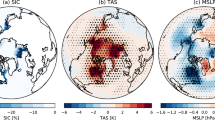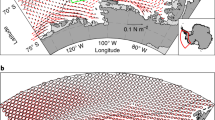Abstract
Assessments of Antarctic temperature change have emphasized the contrast between strong warming of the Antarctic Peninsula and slight cooling of the Antarctic continental interior in recent decades1. This pattern of temperature change has been attributed to the increased strength of the circumpolar westerlies, largely in response to changes in stratospheric ozone2. This picture, however, is substantially incomplete owing to the sparseness and short duration of the observations. Here we show that significant warming extends well beyond the Antarctic Peninsula to cover most of West Antarctica, an area of warming much larger than previously reported. West Antarctic warming exceeds 0.1 °C per decade over the past 50 years, and is strongest in winter and spring. Although this is partly offset by autumn cooling in East Antarctica, the continent-wide average near-surface temperature trend is positive. Simulations using a general circulation model reproduce the essential features of the spatial pattern and the long-term trend, and we suggest that neither can be attributed directly to increases in the strength of the westerlies. Instead, regional changes in atmospheric circulation and associated changes in sea surface temperature and sea ice are required to explain the enhanced warming in West Antarctica.
This is a preview of subscription content, access via your institution
Access options
Subscribe to this journal
Receive 51 print issues and online access
$199.00 per year
only $3.90 per issue
Buy this article
- Purchase on Springer Link
- Instant access to full article PDF
Prices may be subject to local taxes which are calculated during checkout




Similar content being viewed by others
References
Turner, J. et al. Antarctic climate change during the last 50 years. Int. J. Climatol. 25, 279–294 (2005)
Thompson, D. W. J. & Solomon, S. Interpretation of recent Southern Hemisphere climate change. Science 296, 895–899 (2002)
Bromwich, D. H. & Fogt, R. L. Strong trends in the skill of the ERA-40 and NCEP-NCAR Reanalyses in the high and midlatitudes of the southern hemisphere, 1958–2001. J. Clim. 17, 4603–4619 (2004)
Schneider, D. P., Steig, E. J. & Comiso, J. Recent climate variability in Antarctica from satellite-derived temperature data. J. Clim. 17, 1569–1583 (2004)
Doran, P. T. et al. Antarctic climate cooling and terrestrial ecosystem response. Nature 415, 517–520 (2002)
Chapman, W. L. & Walsh, J. E. A synthesis of Antarctic temperatures. J. Clim. 20, 4096–4117 (2007)
Monaghan, A. J., Bromwich, D. H., Chapman, W. & Comiso, J. C. Recent variability and trends of Antarctic near-surface temperature. J. Geophys. Res. 113 1029/2007JD009094 (2008)
Comiso, J. C. Variability and trends in Antarctic surface temperatures from in situ and satellite infrared measurements. J. Clim. 13, 1674–1696 (2000)
Rutherford, S. et al. Proxy-based Northern Hemisphere surface temperature reconstructions: Sensitivity to methodology, predictor network, target season and target domain. J. Clim. 18, 2308–2329 (2005)
Mann, M. E., Rutherford, S., Wahl, E. & Ammann, C. Robustness of proxy-based climate field reconstruction methods. J. Geophys. Res. 112 10.1029/2006JD008272 (2007)
Schneider, T. Analysis of incomplete climate data: Estimation of mean values and covariance matrices and imputation of missing values. J. Clim. 14, 853–871 (2001)
Bromwich, D. H., Monaghan, A. J. & Colwell, S. R. Surface and Mid-tropospheric Climate Change in Antarctica. Eos 89 (Fall meeting), abstr. C41A-0497 (2008)
Shuman, C. A. & Stearns, C. R. Decadal-length composite inland West Antarctic temperature records. J. Clim. 14, 1977–1988 (2001)
Johanson, C. M. & Fu, Q. Antarctic atmospheric temperature trend patterns from satellite observations. Geophys. Res. Lett. 34 1029/2006GL029108 (2007)
Turner, J. et al. Significant warming of the Antarctic winter troposphere. Science 311, 1914–1917 (2006)
Gillett, N. P. & Thompson, D. W. J. Simulation of recent Southern Hemisphere climate change. Science 302, 273–275 (2003)
Shindell, D. T. & Schmidt, G. A. Southern Hemisphere climate response to ozone changes and greenhouse gas increases. Geophys. Res. Lett. 31 10.1029/2004GL020724 (2004)
Keeley, S. P. E. et al. Is Antarctic climate most sensitive to ozone depletion in the middle or lower stratosphere? Geophys. Res. Lett. 34 10.1029/2007GL031238 (2007)
Vaughan, D. G. et al. Recent rapid regional climate warming on the Antarctic Peninsula. Clim. Change 60, 243–274 (2003)
Kwok, R. & Comiso, J. C. Southern Ocean climate and sea ice anomalies associated with the Southern Oscillation. J. Clim. 15, 487–501 (2002)
Parkinson, C. L. Trends in the length of the Southern Ocean sea ice season, 1979–1999. Ann. Glaciol. 34, 435–440 (2002)
Hansen, J. et al. Climate simulations for 1880–2003 with GISS Model E. Clim. Dyn. 29, 661–696 (2007)
Rayner, N. A. et al. Global analyses of sea surface temperature, sea ice and night marine air temperatures since the late nineteenth century. J. Geophys. Res. 108 10.1029/2002JD002670 (2003)
Connolley, W. M. & Bracegirdle, T. J. An Antarctic assessment of IPCC AR4 coupled models. Geophys. Res. Lett. 34 10.1029/2007GL031648 (2007)
Holland, M. M. & Raphael, M. Twentieth century simulation of the Southern Hemisphere in coupled models. Part II: Sea ice conditions and variability. Clim. Dyn. 26, 229–245 (2006)
Miller, R. L., Schmidt, G. A. & Shindell, D. T. Forced annular variations in the 20th Century Intergovernmental Panel on Climate Change Fourth Assessment Report models. J. Geophys. Res. 111 10.1029/2005JD006323 (2006)
Schneider, D. P. & Steig, E. J. Ice cores record significant 1940s Antarctic warmth related to tropical climate variability. Proc. Natl Acad. Sci. USA 105, 12154–12158 (2008)
Jones, P. D. & Moberg, A. Hemispheric and large-scale surface air temperature variations: An extensive revision and an update to 2001. J. Clim. 16, 206–223 (2003)
Reynolds, R. W. et al. An improved in situ and satellite SST analysis for climate. J. Clim. 15, 1609–1625 (2002)
Fierro, R. D., Golub, G. H., Hansen, P. C. & O’Leary, D. P. Regularization by truncated total least squares. SIAM J. Sci. Comput. 18, 1223–1241 (1997)
Acknowledgements
E.J.S. and D.P.S. were supported by the US National Science Foundation, grant numbers OPP-0440414 and OPP-0126161, as part of the US ITASE programme. M.E.M. was supported by the US National Science Foundation, grant number OPP-0125670. We thank D. Winebrenner, A. Monaghan, D. Bromwich, J. Turner, P. Mayewski, T. Scambos, E. Bard and O. Bellier.
Author Contributions E.J.S., D.P.S., S.D.R. and M.E.M. made the reconstruction and statistical calculations. J.C.C. performed the cloud-masking calculations and provided the updated satellite data set. D.T.S. provided the general circulation model output and guided its interpretation. E.J.S. wrote the paper. All authors discussed the results and commented on the manuscript.
Author information
Authors and Affiliations
Corresponding author
Supplementary information
Supplementary Information
This file contains Supplementary Data, Supplementary Figures S1-S1 with Legends and Supplementary Tables S1-S2 (PDF 772 kb)
Rights and permissions
About this article
Cite this article
Steig, E., Schneider, D., Rutherford, S. et al. Warming of the Antarctic ice-sheet surface since the 1957 International Geophysical Year. Nature 457, 459–462 (2009). https://doi.org/10.1038/nature07669
Received:
Accepted:
Issue Date:
DOI: https://doi.org/10.1038/nature07669
This article is cited by
-
Evaluation of trends and analysis of air temperature and wind on the Antarctic Peninsula using extreme value theory
Theoretical and Applied Climatology (2024)
-
The quandary of detecting the signature of climate change in Antarctica
Nature Climate Change (2023)
-
Connection between the Tropical Pacific and Indian Ocean and Temperature Anomaly across West Antarctic
npj Climate and Atmospheric Science (2023)
-
Antarctic daily mesoscale air temperature dataset derived from MODIS land and ice surface temperature
Scientific Data (2023)
-
Surface warming from altitudinal and latitudinal amplification over Antarctica since the International Geophysical Year
Scientific Reports (2023)
Comments
By submitting a comment you agree to abide by our Terms and Community Guidelines. If you find something abusive or that does not comply with our terms or guidelines please flag it as inappropriate.



